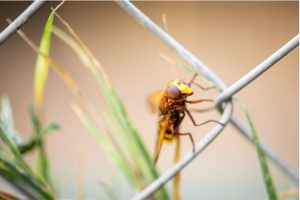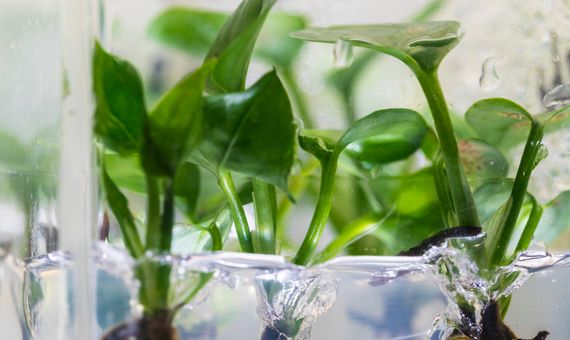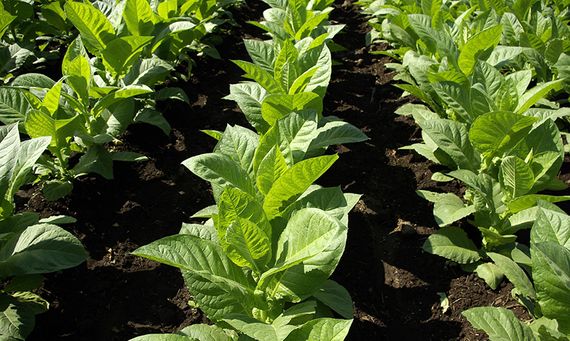The latest and dizzying advances in genetic engineering and the emergence of a new and revolutionary discipline—plant nanobionics—means that a future is just around the corner in which plant species are custom-designed in the laboratory. The motivation for researchers is not just to maximise their nutritional properties or their adaptability and resistance to different environments and climatic conditions. Plants are also capable of developing functions and applications that are alien to their nature, such as purifying the environment, illuminating public roads and the interiors of homes, and even detecting explosives and terrorist threats.
A textile with superpowers
In the same way that Batman or Ironman’s suits endow them with superpowers, some plants can also be supercharged when covered with a special suit. Such is the case with Plant Armor, developed by researchers at North Carolina State University. This textile covering is characterised by its particular internal structure: a three-dimensional network composed of three layers of knitted fabric, with the middle layer arranged perpendicular to the other two. This intricate design becomes a labyrinth for insects.

Existing plant covers base their effectiveness on the size of the openings, but this has a drawback: if the pores are small enough to keep out the tiniest insects, they can also prevent water droplets and air from passing through. Thus, there is the dilemma of either leaving the crop exposed to attack from pests or limiting the supply of basic resources. In tests—both laboratory and field—Plant Armor has proven its superiority over conventional crop covers; it increases the time it takes for an insect to gain access to the plant by a factor of 25. In a three-month outdoor field trial, the use of Plant Armor produced larger than usual plants, and cabbages three times heavier than the control group, without the use of chemicals.
Indoor plants that purify the air
During the past month of December, researchers from the University of Washington announced their success in the creation, thanks to genetic engineering, of one of these “air-scrubbing” plants.
Specifically, it is a genetically modified version of the popular pothos plant, also known as Devil’s Ivy (Epipremnum aureum), that’s capable of eliminating chloroform and benzene (two carcinogenic compounds). The team’s success was achieved after developing a version of an artificial gene that encodes cytochrome P4502E1, a protein that occurs naturally in the liver of mammals and that permits the degradation of the aforementioned compounds.

The artificial gene was introduced into the genetic material of the plant so that it was present in the cells of the leaves, and it was found that the new specimens reduced the air concentration of benzene and chloroform by more than 75%.
This is only the first step, since the objective is to create a battery of indoor plants capable of eliminating the different pollutants in the air, so that being at home becomes the closest thing to breathing pure air. In fact, they are already working on the introduction of a synthetic gene that encodes a protein that degrades formaldehyde, another usual suspect that is present in a multitude of objects made of wood—from furniture to floor sheeting—and in tobacco smoke.
Plants to detect terrorist threats
Plant nanobionics is a revolutionary new discipline that is based on the introduction of nanostructures into plants in order to provide them with extra capabilities and functions that don’t occur in nature. The leading exponent of this discipline is the engineering group led by Michael Strano at MIT, which in 2016 managed to develop spinach that could detect the presence of explosive substances in its surroundings.
To achieve this, they introduced in the leaves of the plants carbon nanotubes coated with a polymer that binds to compounds usually present in explosives, such as nitroaromatic derivatives. In this way, when one of these compounds reaches the leaves, either through its stomata—the pores through which the leaves “breathe”—or through the roots, it bonds with the polymer and produces a fluorescence that activates an alarm when detected.
In addition to explosives, the MIT laboratories have designed nanotubes and polymers capable of detecting a wide variety of dangerous compounds: toxic and poisonous substances such as hydrogen peroxide or sarin gas. One can imagine a not-too-distant future in which hedges or planters located in public spaces—such as squares, airports, subways and train stations—are capable of monitoring and detecting these kinds of threats.
Wild wheat with super-immunity
Aegilops sharonensis is an herbaceous plant of the grass family that is itself of no interest as a crop because of its slow growth and tough outer covering. But this wild relative of wheat—endemic to a small strip of land between Israel and southern Lebanon—has one characteristic that makes it superior to other cereals: super-immunity. This variant is highly resistant to pest attack, especially against the dreaded stem rust, a fungus species that is particularly vicious in wheat plantations.

The key lies in a newly identified gene, the so-called Sr62, which is not present in other wheat varieties or in other cereals. While this resistance was already well known, until now all attempts to hybridise it with commercial wheat had failed due to difficulties in obtaining a viable plant. But Sr62 promises to change the situation. The aim now is to introduce it through genetic engineering techniques to produce a marketable hybrid that is immune to its arch enemy.
Bioluminescent plants to light up cities
Bioluminescence is a process by which some organisms—from bacteria and fungi to fish and fireflies—are able to produce light through a chemical reaction inside their cells. It works by the oxidation of a compound that these organisms produce—luciferin—through the intermediation of a luciferase enzyme. Recently, an international team has managed to identify the three genes that allow these organisms to synthesise luciferin.
Thanks to this discovery, the researchers have been able to insert this triad of genes, as well as the gene that encodes the luciferin, into the genetic material of non-luminous organisms to incite them to glow. In the words of one of those responsible for the work, “this discovery can lead to sci-fi scenarios in which glowing plants replace street lights… although it may take several years to achieve it.”
This science fiction scenario had already been envisaged just a year earlier by MIT engineers, who were able to create plants that emitted light using nanobionics through the introduction of light-emitting nanoparticles in the leaves. Specifically, they created two types of nanoparticles that contained luciferase and luciferin, respectively, and that, once inside the plant, released them to mimic natural bioluminescence. The purpose was to create plants that would act as a source of domestic lighting.
Magic beans that aren’t a fairy tale
As in the tale of Jack and the Beanstalk, a group of American researchers has managed to accelerate the growth of plants. Through the application of genetic engineering, they have designed an “improved” method of photosynthesis that increases the productivity of crops.

Although photosynthesis is one of the most incredible and successful processes in nature—it allows plants to grow from a few nutrients and the sun’s energy—it’s not perfect. One of its main limitations is that the enzyme that catalyses the conversion of CO2 (and water) into sugars is not able to distinguish between that molecule and that of oxygen. Consequently, about one in five times it binds to the latter and generates a plant-toxic compound that must be recycled through photorespiration. Like any metabolic process, this requires a consumption of energy and resources that the plant stops investing in photosynthesis.
As the authors of the study explain: “We could feed up to 200 million additional people with the calories lost to photorespiration in the Midwestern U.S. each year.” With this mind, the researchers managed to obtain a GM variant of tobacco with an improved photorespiration process that minimises its energy expenditure. This translates into plants that grow up to 40% more than their natural congeners. And now they are trying to transfer this modification to some of the most widespread crops, such as potatoes, soybeans and rice.
Comments on this publication